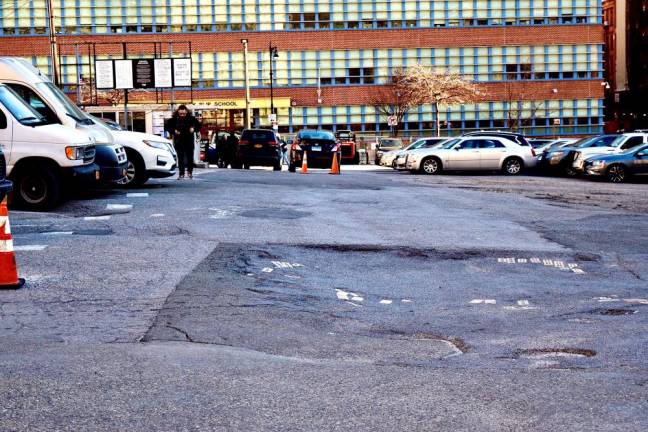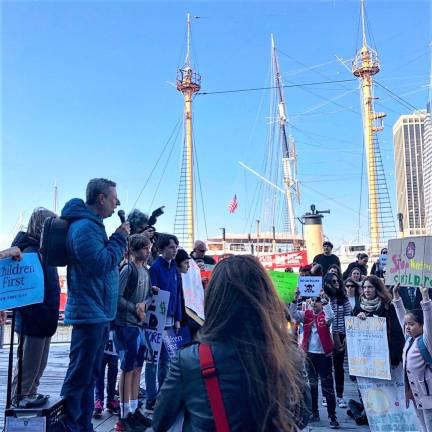What Lies Beneath the Blacktop?
Community members and officials are alarmed about early steps in the planned cleanup of a toxic site at the South Street Seaport


A grassroots community organization and a group of elected officials are not pleased with a proposed plan to investigate the condition of the site of a former thermometer factory — situated at the doorsteps of two schools and senior housing — in the South Street Seaport. They are asking a city agency to make changes to the draft plan before it’s approved.
Parents and residents became alarmed after contaminates, including elemental mercury, petroleum and other semi-volatile organic compounds, were found under the surface of site, a parking lot at 250 Water Street that was purchased by the Howard Hughes Corp. for $180 million in 2018.
Since the discovery, the New York State Department of Environmental Conservation (DEC) has approved the corporation’s application to be included in the state’s Brownfield Cleanup Program, which is typically used to revitalize economically blighted communities by incentivizing private-sector cleanups with tax credits. Howard Hughes has been the major driver of the development taking place in the seaport, including the construction of the Pier 17 concert venue.
As required by the state, Langan Engineering, on behalf of Howard Hughes, submitted a draft of the work plan by which the company would investigate the site in order to gain a fuller picture of what lies beneath the blacktop. It’s the first in a series of steps before the cleanup can begin — but already community leaders, who have been distrustful of Howard Hughes from the start, have declared the draft to be “insufficient.”
'A Glaring Data Gap'
“(The draft) needs to be revised to ensure the health and safety of the community,” said Megan Malvern, a co-founder of the grassroots organization Children First, which formed last year in response to the discovery of the toxins. The group so far has been vigilant and taken steps to be a part of the process. In tandem with the greater Seaport Coalition, and with the help of Manhattan Borough President Gale Brewer, the group has obtained a $50,000 grant from Howard Hughes to hire a Independent Community Monitor (ICM) to represent the community through the process.
The group chose Lawra Dodge, of Excel Environmental Resources, who has 36 years of experience dealing with investigations and cleanups of this nature.
Grace Lee, the other co-founder of Children First, said gaining the guidance and support of Dodge has been crucial and has made the group feel “vindicated and validated” in that their concerns with the process are reasonable.
“The developer does the investigation — and not that they would — so they could manipulate the investigation to be more favorable to them,” said Lee.
Dodge has submitted comments to DEC in regard to the draft work plan, citing the holes the community sees in the proposal, one of which includes an apparent lack of data in the draft.
“The approach to the cleanup should be methodical, phased and data-driven,” said Malvern. “There is no field information on elemental mercury vapor from the site, despite more than 60 years of historical ties to thermometer manufacturing — this is a glaring data gap that must be addressed.”
Additionally, Children First is asking the DEC and the Department of Health to hold meetings with community stakeholders and Howard Hughes so that the community members can remain informed and voice their concerns throughout the process.
“We need to have face-to-face technical meetings so that the site is properly characterized in order to proceed in a manner that is safe for the community," said Grace Lee, a co-founder of Children First.
Elected Officials Weigh In
In a letter of their own to DEC, U.S. Congressman Jerry Nadler, state Senator Brian Kavanaugh, Assembly Member Yuh-Line Niou and the city Comptroller Scott Stringer call on DEC to “enhance” the draft plan in four areas: comprehensiveness of the investigation, monitoring and protective measures, community notification and communication, and the status of the parking lot during investigation.
“We must request additional measures be added to the existing draft plan to guarantee that the remediation investigation process is conducted in the most thorough, transparent, and constructive manner possible,” the letter stated.
The specific measures the elected officials have requested include: a narrowing of the sample grid to limit the possibility of missing a certain level or type of contaminate; doubling the number of monitors stationed on the perimeter of the work site to ensure hazardous fumes don’t escape the site without detection; a communication strategy to alert stakeholders when work is halted due to elevated levels of chemicals; and the asphalt cap on the parking lot should be required to be maintained in place until all land use, zoning, building permit, or other approvals are received.
“Based on the draft plan released by DEC, there is still more work to be done to ensure the community’s voice is fully heard and their safety is prioritized above all else,” the letter stated. “Making the draft plan more thorough, improving communication and site monitoring, and minimizing opportunities for danger would help the BCP meet its goals.”
The public comment period for the draft work plan ended on Jan. 16 and DEC is in the process of reviewing the public’s input. A spokesperson for said once the review is complete, it will be revised as necessary. Both DEC and DOH must sign off on the draft before any work at the site can begin.
Malvern said Children First is grateful to the elected officials, as well as Community Board 1, for speaking out on their behalf. “There will be many stages to this site's redevelopment,” Malvern said. “We look forward to the ideas, expertise and continued political support from our representatives over that timeline.”